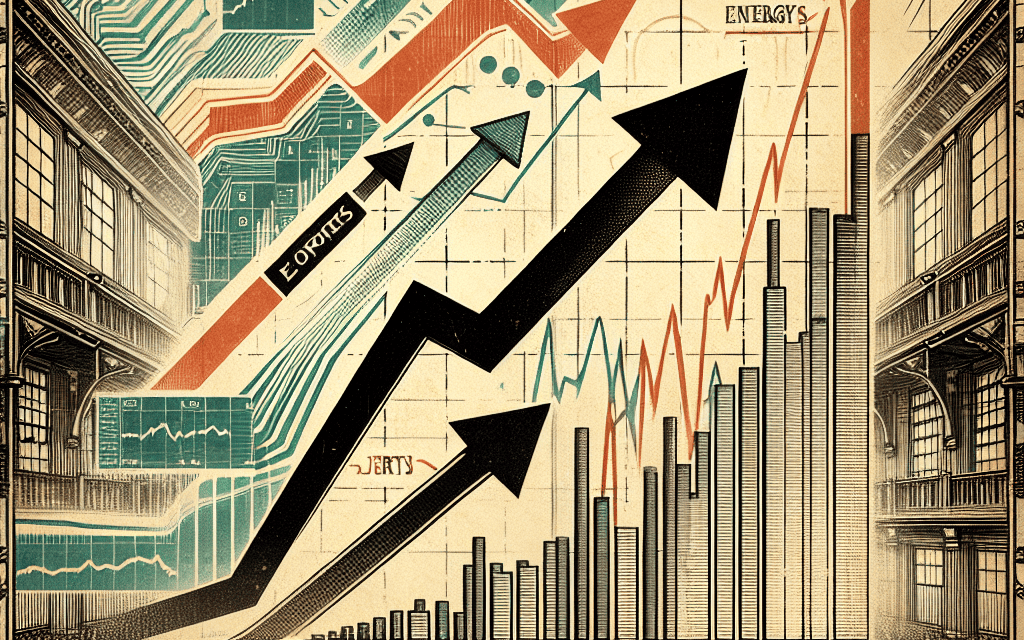“Powering Ahead: Energy and Auto Parts Stocks Soar While Marvell Faces a Dip”
Introduction
Energy and auto parts stocks have recently experienced a significant surge, reaching new highs in the market. This upward trend reflects growing investor confidence in these sectors, driven by factors such as rising demand for energy resources and advancements in automotive technology. In contrast, Marvell Technology, a prominent player in the semiconductor industry, has seen a decline in its stock value. This divergence highlights the dynamic nature of the stock market, where sector-specific developments and broader economic trends can lead to varying performances among different industries. As energy and auto parts stocks continue to climb, market analysts are closely monitoring the factors contributing to these gains and the potential implications for future investment strategies.
Energy Stocks Reach New Highs Amid Market Shifts
In recent weeks, the financial markets have witnessed a notable surge in energy and auto parts stocks, reaching unprecedented highs. This upward trajectory can be attributed to a confluence of factors that have collectively bolstered investor confidence in these sectors. Meanwhile, Marvell Technology, a prominent player in the semiconductor industry, has experienced a decline, highlighting the contrasting fortunes within the market.
The energy sector’s remarkable performance can be largely attributed to the global shift towards sustainable energy solutions and the increasing demand for cleaner alternatives. As governments worldwide implement policies to reduce carbon emissions and transition to renewable energy sources, companies within the energy sector have found themselves at the forefront of this transformation. This shift has not only driven up the demand for energy stocks but has also encouraged significant investments in research and development, further propelling the sector’s growth.
Moreover, the recent geopolitical tensions and supply chain disruptions have underscored the importance of energy security, prompting countries to diversify their energy sources. This has led to increased investments in domestic energy production, particularly in renewable energy projects such as wind, solar, and hydroelectric power. Consequently, energy companies that have positioned themselves as leaders in these areas have seen their stock prices soar, reflecting the market’s optimism about their future prospects.
Simultaneously, the auto parts industry has experienced a resurgence, driven by the rapid evolution of the automotive sector. The transition towards electric vehicles (EVs) has created a burgeoning demand for specialized auto parts, including batteries, electric drivetrains, and advanced electronic components. As traditional automakers and new entrants alike race to capture a share of the growing EV market, suppliers of these critical components have witnessed a surge in orders, translating into robust financial performance and heightened investor interest.
Furthermore, the push for innovation in vehicle technology, such as autonomous driving and connected car systems, has further fueled the demand for sophisticated auto parts. Companies that have successfully adapted to these technological advancements have been rewarded with increased market share and investor confidence, driving their stock prices to new heights.
In stark contrast, Marvell Technology has faced challenges that have led to a decline in its stock value. Despite being a key player in the semiconductor industry, Marvell has been impacted by the broader market dynamics affecting the tech sector. The semiconductor industry, while crucial to numerous technological advancements, has been grappling with supply chain constraints and fluctuating demand patterns. These challenges have been exacerbated by the global economic uncertainties, leading to a cautious approach from investors.
Additionally, Marvell’s recent financial performance has not met market expectations, further contributing to the decline in its stock price. While the company continues to invest in strategic initiatives aimed at capturing growth opportunities in areas such as data centers and 5G technology, the immediate market sentiment remains subdued.
In conclusion, the contrasting fortunes of energy and auto parts stocks compared to Marvell Technology underscore the dynamic nature of the financial markets. As the world continues to navigate the complexities of energy transition and technological innovation, investors are keenly attuned to the sectors that are poised for growth. While energy and auto parts stocks have surged to new highs, driven by favorable market conditions and strategic positioning, Marvell’s decline serves as a reminder of the challenges that can arise even in industries with significant growth potential.
Auto Parts Industry Sees Unprecedented Stock Surge
The auto parts industry has recently experienced an unprecedented surge in stock prices, capturing the attention of investors and analysts alike. This remarkable growth can be attributed to several key factors that have converged to create a favorable environment for companies within this sector. As the global economy continues to recover from the disruptions caused by the pandemic, there is a renewed focus on the automotive industry, which has been further bolstered by the increasing demand for electric vehicles (EVs) and advancements in automotive technology.
One of the primary drivers of this surge is the growing emphasis on sustainability and the transition towards cleaner energy sources. Governments worldwide are implementing stringent regulations to reduce carbon emissions, prompting automakers to accelerate their shift towards EVs. Consequently, auto parts manufacturers are experiencing heightened demand for components that support this transition, such as batteries, electric drivetrains, and advanced electronic systems. This shift is not only reshaping the automotive landscape but also providing lucrative opportunities for companies that can supply these critical components.
Moreover, the global supply chain disruptions that plagued the industry over the past few years are gradually easing, allowing auto parts manufacturers to ramp up production and meet the rising demand. The resolution of these bottlenecks has been instrumental in restoring investor confidence, as companies are now better positioned to fulfill orders and capitalize on the growing market. Additionally, the adoption of innovative technologies, such as artificial intelligence and automation, is enhancing production efficiency and reducing costs, further contributing to the positive outlook for the sector.
In parallel, the energy sector is also witnessing a surge in stock prices, driven by similar trends towards sustainability and clean energy. The increasing adoption of renewable energy sources, such as solar and wind power, is creating a robust market for energy companies that are at the forefront of this transition. As a result, investors are flocking to these stocks, recognizing the long-term potential for growth and profitability. This surge in energy stocks is closely linked to the developments in the auto parts industry, as both sectors are integral to the broader shift towards a more sustainable future.
However, not all companies are benefiting from this upward trend. Marvell Technology, a prominent player in the semiconductor industry, has seen a decline in its stock prices. This downturn can be attributed to several factors, including supply chain challenges and increased competition in the semiconductor market. As the demand for semiconductors continues to outpace supply, companies like Marvell are facing difficulties in meeting customer needs, leading to a negative impact on their stock performance. Furthermore, the rapid pace of technological advancements in the semiconductor industry is intensifying competition, putting pressure on companies to innovate and maintain their market position.
In conclusion, the auto parts industry is experiencing a remarkable surge in stock prices, driven by the global shift towards sustainability and the increasing demand for electric vehicles. This growth is further supported by the easing of supply chain disruptions and the adoption of advanced technologies. Simultaneously, the energy sector is also benefiting from similar trends, as investors recognize the potential for long-term growth in renewable energy. However, challenges remain for companies like Marvell Technology, which are grappling with supply chain issues and heightened competition. As these industries continue to evolve, it will be crucial for companies to adapt and innovate to sustain their growth and capitalize on emerging opportunities.
Factors Driving the Rise in Energy and Auto Parts Stocks
The recent surge in energy and auto parts stocks to new highs has captured the attention of investors and analysts alike, marking a significant shift in market dynamics. This upward trajectory can be attributed to a confluence of factors that have created a favorable environment for these sectors. Meanwhile, Marvell Technology’s decline serves as a contrasting backdrop, highlighting the unique circumstances propelling energy and auto parts stocks forward.
To begin with, the energy sector has experienced a resurgence driven by a combination of geopolitical tensions and supply chain disruptions. These factors have led to increased volatility in global oil prices, prompting investors to seek opportunities within the energy market. As countries navigate the complexities of energy security, there has been a renewed focus on domestic production and alternative energy sources. This shift has benefited companies involved in both traditional fossil fuels and renewable energy, as they are poised to meet the growing demand for diverse energy solutions.
Moreover, the transition towards cleaner energy has gained momentum, supported by government policies and international agreements aimed at reducing carbon emissions. This has spurred investment in renewable energy infrastructure, such as wind and solar power, further boosting the prospects of companies operating in these areas. As a result, energy stocks have become increasingly attractive to investors looking to capitalize on the long-term growth potential of sustainable energy solutions.
Simultaneously, the auto parts industry has experienced a robust upswing, driven by the global recovery in automotive production and sales. As economies rebound from the disruptions caused by the COVID-19 pandemic, there has been a resurgence in consumer demand for vehicles. This has led to increased production levels, thereby benefiting auto parts manufacturers who supply essential components to the automotive industry. Additionally, the ongoing shift towards electric vehicles (EVs) has created new opportunities for auto parts companies specializing in EV components, further fueling their growth.
The rise in auto parts stocks is also supported by advancements in technology and innovation within the industry. Companies are investing heavily in research and development to enhance the efficiency and performance of their products. This focus on innovation has enabled auto parts manufacturers to meet the evolving needs of automakers, positioning them as key players in the transition towards more sustainable and technologically advanced vehicles.
In contrast, Marvell Technology’s decline can be attributed to a different set of challenges. The semiconductor industry, in which Marvell operates, has faced significant headwinds due to supply chain disruptions and fluctuating demand patterns. While the demand for semiconductors remains strong, the industry’s ability to meet this demand has been hampered by shortages and logistical constraints. Consequently, companies like Marvell have experienced volatility in their stock performance as they navigate these challenges.
In conclusion, the rise in energy and auto parts stocks can be attributed to a combination of geopolitical factors, technological advancements, and shifting consumer preferences. These sectors have demonstrated resilience and adaptability in the face of changing market conditions, positioning themselves for continued growth. Meanwhile, Marvell Technology’s decline underscores the complexities faced by the semiconductor industry, highlighting the divergent paths taken by different sectors in the current economic landscape. As investors continue to assess these dynamics, the interplay between these factors will likely shape market trends in the coming months.
Marvell Technology’s Decline: Impact on the Tech Sector

In recent weeks, the financial markets have witnessed a notable divergence in sector performance, with energy and auto parts stocks reaching unprecedented highs while Marvell Technology experiences a significant decline. This shift in market dynamics has raised questions about the broader implications for the tech sector, as investors reassess their portfolios in response to evolving economic conditions and industry-specific challenges.
Marvell Technology, a prominent player in the semiconductor industry, has faced a series of setbacks that have contributed to its declining stock value. The company’s recent earnings report fell short of analysts’ expectations, primarily due to supply chain disruptions and increased competition in the semiconductor market. These challenges have not only impacted Marvell’s financial performance but have also raised concerns about the resilience of the tech sector as a whole. As a result, investors are increasingly cautious, leading to a reallocation of capital towards sectors perceived as more stable and promising in the current economic climate.
The energy sector, in contrast, has experienced a surge in stock prices, driven by a combination of rising global demand and geopolitical factors that have tightened supply. As economies around the world continue to recover from the pandemic, energy consumption has increased, leading to higher prices for oil and natural gas. This trend has benefited energy companies, whose stocks have become attractive to investors seeking to capitalize on the sector’s upward momentum. Furthermore, the ongoing transition towards renewable energy sources has spurred innovation and investment in the sector, providing additional growth opportunities for companies involved in the development and deployment of clean energy technologies.
Similarly, the auto parts industry has seen a remarkable upswing, fueled by the growing demand for electric vehicles (EVs) and advancements in automotive technology. As governments implement stricter emissions regulations and consumers become more environmentally conscious, the shift towards EVs has accelerated. This transition has created a robust market for auto parts manufacturers, particularly those specializing in components for electric and hybrid vehicles. Consequently, investors have shown increased interest in auto parts stocks, recognizing the potential for sustained growth in this evolving industry.
The contrasting fortunes of Marvell Technology and the energy and auto parts sectors underscore the importance of diversification in investment strategies. While the tech sector has long been a favorite among investors due to its rapid innovation and growth potential, recent challenges have highlighted the need for a balanced approach that considers both high-growth and stable sectors. As the market continues to navigate uncertainties, including inflationary pressures and geopolitical tensions, investors are likely to remain vigilant, seeking opportunities that offer both resilience and potential for returns.
In conclusion, the decline of Marvell Technology serves as a reminder of the volatility inherent in the tech sector, prompting investors to explore alternative avenues for growth. The concurrent rise of energy and auto parts stocks reflects broader economic trends and shifting consumer preferences, offering a glimpse into the future landscape of global markets. As these sectors continue to evolve, they present both challenges and opportunities for investors, who must remain agile and informed to navigate the complexities of an ever-changing financial environment.
Investment Opportunities in Energy and Auto Parts Stocks
In recent months, the financial markets have witnessed a notable surge in energy and auto parts stocks, reaching unprecedented highs. This upward trajectory has captured the attention of investors seeking lucrative opportunities in these sectors. The robust performance of these stocks can be attributed to a confluence of factors, including rising global energy demands, technological advancements in the automotive industry, and strategic shifts in consumer preferences. As these sectors continue to thrive, they present compelling investment opportunities for those looking to diversify their portfolios.
The energy sector, in particular, has experienced a remarkable resurgence. With the global economy gradually recovering from the disruptions caused by the pandemic, energy consumption has increased significantly. This surge in demand has been further fueled by the transition towards cleaner energy sources, as governments and corporations worldwide commit to reducing carbon emissions. Consequently, companies involved in renewable energy, such as solar and wind power, have seen their stock prices soar. Additionally, traditional energy companies have also benefited from rising oil and gas prices, driven by geopolitical tensions and supply chain constraints. As a result, investors are increasingly drawn to energy stocks, recognizing their potential for substantial returns.
Simultaneously, the auto parts industry has emerged as a promising investment avenue. The automotive sector is undergoing a transformative phase, driven by the rapid adoption of electric vehicles (EVs) and advancements in autonomous driving technology. This shift has created a surge in demand for innovative auto parts and components, ranging from batteries and sensors to advanced driver-assistance systems. Companies that specialize in these cutting-edge technologies are experiencing significant growth, as automakers strive to meet the evolving needs of consumers. Moreover, the push for sustainability and environmental consciousness has further accelerated the demand for eco-friendly auto parts, presenting a unique opportunity for investors to capitalize on this trend.
While energy and auto parts stocks continue to climb, it is important to note that not all sectors are experiencing the same level of success. For instance, Marvell Technology, a prominent player in the semiconductor industry, has faced challenges that have led to a decline in its stock value. The semiconductor sector, which was once a darling of the market, is grappling with supply chain disruptions and increased competition. These factors have contributed to Marvell’s recent struggles, highlighting the importance of careful sector analysis and diversification in investment strategies.
In light of these developments, investors are advised to conduct thorough research and consider a balanced approach when exploring opportunities in energy and auto parts stocks. Diversification remains a key principle in mitigating risks and maximizing returns. By spreading investments across different sectors and asset classes, investors can better navigate market fluctuations and capitalize on emerging trends. Furthermore, staying informed about geopolitical developments, technological advancements, and regulatory changes is crucial in making informed investment decisions.
In conclusion, the surge in energy and auto parts stocks presents a compelling opportunity for investors seeking growth and diversification. The confluence of rising energy demands, technological advancements, and shifting consumer preferences has propelled these sectors to new heights. However, it is essential to approach these opportunities with a well-informed and diversified strategy, considering the potential risks and challenges that may arise. By doing so, investors can position themselves to benefit from the dynamic landscape of energy and auto parts stocks while safeguarding their portfolios against market volatility.
Market Analysis: Energy and Auto Parts vs. Tech Stocks
In recent market developments, energy and auto parts stocks have experienced a significant surge, reaching new highs, while technology stocks, particularly Marvell Technology, have faced a decline. This shift in market dynamics highlights the evolving landscape of investment opportunities and the factors influencing these sectors. As investors seek to navigate these changes, understanding the underlying reasons for these movements becomes crucial.
The energy sector has been buoyed by a combination of factors, including rising global demand for oil and gas, geopolitical tensions, and a renewed focus on energy security. As economies continue to recover from the disruptions caused by the COVID-19 pandemic, the demand for energy has surged, driving up prices and, consequently, the value of energy stocks. Additionally, geopolitical tensions in key oil-producing regions have contributed to supply uncertainties, further supporting higher prices. This environment has created a favorable backdrop for energy companies, which are now reaping the benefits of increased revenues and profitability.
Simultaneously, the auto parts industry has witnessed a robust performance, driven by the ongoing transformation of the automotive sector. The shift towards electric vehicles (EVs) and the increasing integration of advanced technologies in automobiles have spurred demand for specialized auto parts. Companies that supply components for EVs, such as batteries and electronic systems, are particularly well-positioned to capitalize on this trend. As governments worldwide implement stricter emissions regulations and incentivize the adoption of cleaner vehicles, the auto parts sector is poised for sustained growth.
In contrast, the technology sector, which has been a dominant force in the market for years, is experiencing a period of recalibration. Marvell Technology, a prominent player in the semiconductor industry, has seen its stock decline amid concerns over supply chain disruptions and changing market dynamics. The semiconductor shortage, which has affected various industries, including automotive and consumer electronics, has highlighted vulnerabilities in the tech supply chain. As a result, companies like Marvell are facing challenges in meeting demand, leading to investor apprehension.
Moreover, the technology sector is grappling with broader macroeconomic factors, such as rising interest rates and inflationary pressures. These elements have prompted investors to reassess the valuations of tech stocks, which have historically been driven by growth expectations. As interest rates rise, the cost of capital increases, potentially impacting the profitability of tech companies that rely heavily on borrowing for expansion. Consequently, investors are shifting their focus towards sectors that offer more immediate returns and stability, such as energy and auto parts.
Despite the current challenges facing the technology sector, it is important to recognize that these fluctuations are part of the natural ebb and flow of the market. The tech industry remains a cornerstone of innovation and economic growth, and its long-term prospects continue to be promising. However, the recent surge in energy and auto parts stocks underscores the importance of diversification in investment portfolios. By balancing exposure across different sectors, investors can mitigate risks and capitalize on emerging opportunities.
In conclusion, the recent market trends reflect a dynamic interplay between various sectors, each influenced by distinct factors. While energy and auto parts stocks are enjoying a period of growth, technology stocks like Marvell are navigating a complex landscape. As investors adapt to these changes, a comprehensive understanding of the market forces at play will be essential in making informed investment decisions.
Future Outlook for Energy and Auto Parts Stocks in 2024
As we look toward 2024, the energy and auto parts sectors are poised for continued growth, building on the momentum that has propelled their stocks to new highs. This surge can be attributed to a confluence of factors, including technological advancements, increased demand, and strategic shifts within these industries. Meanwhile, companies like Marvell Technology, which have experienced declines, highlight the dynamic nature of the market and the importance of adaptability.
The energy sector, in particular, has been buoyed by a global push towards sustainable and renewable energy sources. Governments and corporations alike are investing heavily in green technologies, driven by both regulatory pressures and consumer demand for cleaner energy solutions. This shift is not only transforming the energy landscape but also creating lucrative opportunities for companies that can innovate and lead in this space. As a result, energy stocks have seen significant appreciation, reflecting investor confidence in the sector’s long-term potential.
Moreover, the auto parts industry is experiencing a renaissance, largely due to the rapid evolution of the automotive sector. The transition to electric vehicles (EVs) is a major catalyst, as traditional automakers and new entrants alike race to capture market share in this burgeoning field. This shift necessitates a reimagining of the supply chain, with a focus on components that support EV technology, such as batteries and advanced electronics. Consequently, auto parts manufacturers that can adapt to these changes are well-positioned to thrive, as evidenced by the recent surge in their stock prices.
In contrast, Marvell Technology’s recent decline serves as a reminder of the challenges that can arise in rapidly evolving industries. While Marvell has been a key player in the semiconductor space, the sector is notoriously volatile, subject to fluctuations in demand and supply chain disruptions. Additionally, the competitive landscape is fierce, with numerous companies vying for dominance in areas like data centers, 5G, and artificial intelligence. For Marvell, staying ahead of the curve will require strategic investments in research and development, as well as agile responses to market shifts.
Looking ahead to 2024, the outlook for energy and auto parts stocks remains optimistic. The global commitment to reducing carbon emissions and achieving net-zero targets will continue to drive investment in renewable energy projects. This trend is likely to benefit companies involved in solar, wind, and other clean energy technologies. Furthermore, as the automotive industry accelerates its transition to electric vehicles, demand for innovative auto parts will persist, providing a robust growth trajectory for manufacturers that can meet these needs.
However, it is essential for investors to remain vigilant and consider potential risks. Geopolitical tensions, regulatory changes, and technological disruptions could impact these sectors. Additionally, the pace of innovation in both energy and automotive industries means that companies must continuously adapt to maintain their competitive edge. Those that can successfully navigate these challenges are likely to emerge as leaders in their respective fields.
In conclusion, the future outlook for energy and auto parts stocks in 2024 is promising, driven by transformative trends and increasing demand for sustainable solutions. While challenges remain, the potential for growth is substantial, offering opportunities for investors who are willing to embrace the evolving landscape. As we move forward, the ability to innovate and adapt will be crucial for companies seeking to capitalize on these trends and achieve long-term success.
Q&A
1. **What caused the surge in energy stocks?**
– Rising oil prices and increased global demand for energy.
2. **Which auto parts companies saw significant gains?**
– Companies like AutoZone, O’Reilly Automotive, and Advance Auto Parts.
3. **What factors contributed to the rise in auto parts stocks?**
– Increased vehicle maintenance and repair demand, and supply chain improvements.
4. **Why did Marvell Technology’s stock decline?**
– Disappointing earnings report and weaker-than-expected guidance.
5. **How did the broader stock market perform during this period?**
– Mixed performance, with energy and auto parts sectors outperforming.
6. **What external factors influenced the energy sector’s performance?**
– Geopolitical tensions and production cuts by major oil-producing countries.
7. **Are there any long-term trends affecting the auto parts industry?**
– Growing focus on electric vehicles and increased vehicle longevity.
Conclusion
The recent market dynamics have seen energy and auto parts stocks reaching new highs, driven by factors such as increased demand, supply chain improvements, and possibly favorable economic conditions. This surge reflects investor confidence in these sectors, likely due to their critical role in supporting economic recovery and growth. Conversely, Marvell’s decline suggests sector-specific challenges or company-specific issues, such as disappointing earnings or market competition, impacting investor sentiment. Overall, while energy and auto parts stocks are benefiting from positive market trends, Marvell’s downturn highlights the variability and sector-specific risks present in the stock market.





